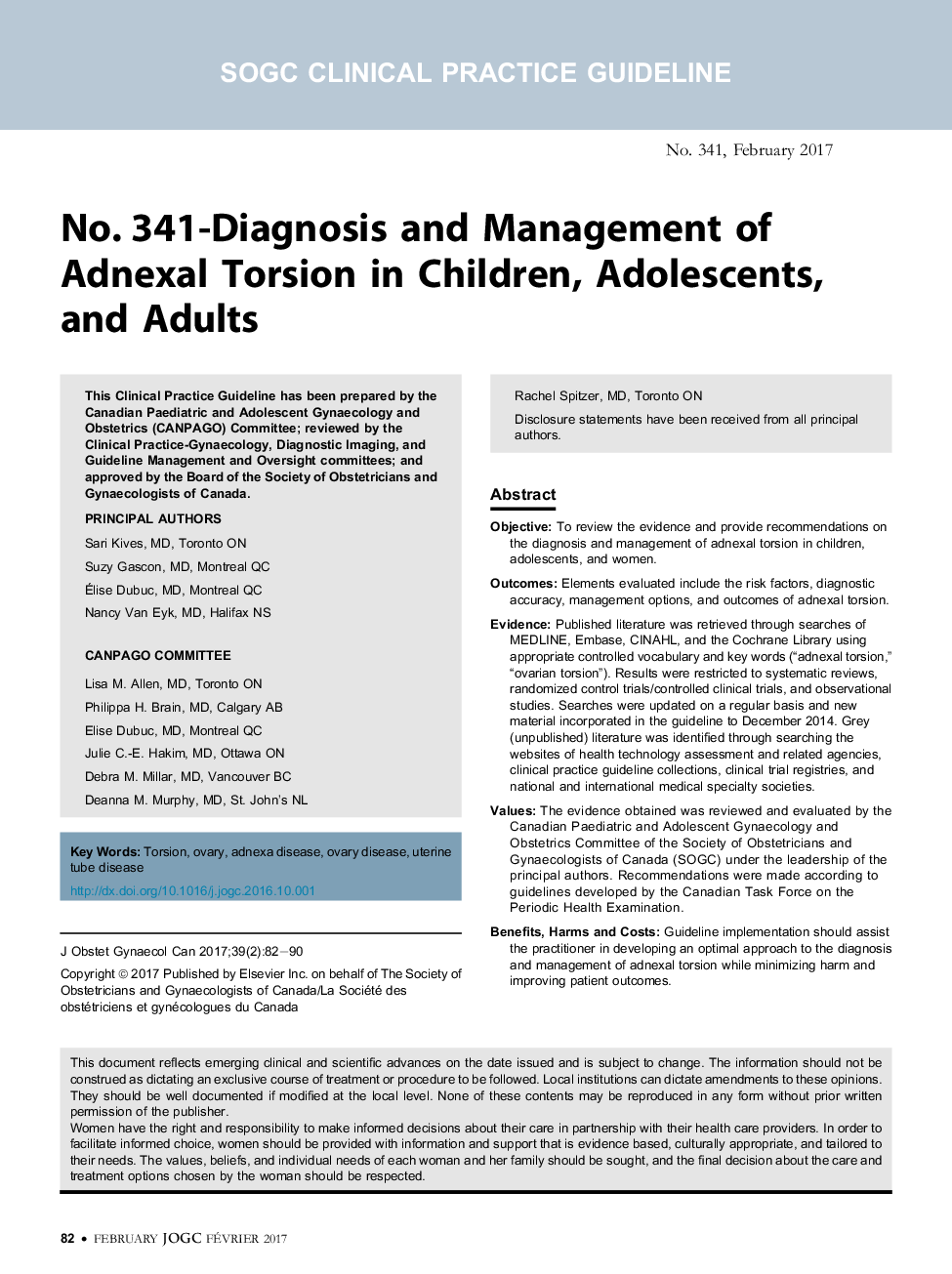| کد مقاله | کد نشریه | سال انتشار | مقاله انگلیسی | نسخه تمام متن |
|---|---|---|---|---|
| 5693532 | 1410170 | 2017 | 9 صفحه PDF | دانلود رایگان |
عنوان انگلیسی مقاله ISI
No. 341-Diagnosis and Management of Adnexal Torsion in Children, Adolescents, and Adults
ترجمه فارسی عنوان
شماره 341- تشخیص و مدیریت پیچشی آدنکسال در کودکان، نوجوانان و بزرگسالان
دانلود مقاله + سفارش ترجمه
دانلود مقاله ISI انگلیسی
رایگان برای ایرانیان
کلمات کلیدی
IL-6PPVCDUpositive predictive value - ارزش پیش بینی مثبتMRI - امآرآی یا تصویرسازی تشدید مغناطیسیinterleukin-6 - اینترلوکین ۶Ovary - تخمدانMagnetic resonance imaging - تصویربرداری رزونانس مغناطیسیcomputed tomography - توموگرافی کامپیوتری یا سی تی اسکن یا مقطعنگاری رایانهایColour Doppler ultrasonography - سونوگرافی داپلر رنگیC-reactive protein - پروتئین واکنشی سیCRP - پروتئین واکنشی سی یا سی. آر. پی torsion - پیچش
موضوعات مرتبط
علوم پزشکی و سلامت
پزشکی و دندانپزشکی
زنان، زایمان و بهداشت زنان
چکیده انگلیسی
ObjectiveTo review the evidence and provide recommendations on the diagnosis and management of adnexal torsion in children, adolescents, and women.OutcomesElements evaluated include the risk factors, diagnostic accuracy, management options, and outcomes of adnexal torsion.EvidencePublished literature was retrieved through searches of MEDLINE, Embase, CINAHL, and the Cochrane Library using appropriate controlled vocabulary and key words (“adnexal torsion,” “ovarian torsion”). Results were restricted to systematic reviews, randomized control trials/controlled clinical trials, and observational studies. Searches were updated on a regular basis and new material incorporated in the guideline to December 2014. Grey (unpublished) literature was identified through searching the websites of health technology assessment and related agencies, clinical practice guideline collections, clinical trial registries, and national and international medical specialty societies.ValuesThe evidence obtained was reviewed and evaluated by the Canadian Paediatric and Adolescent Gynaecology and Obstetrics Committee of the Society of Obstetricians and Gynaecologists of Canada (SOGC) under the leadership of the principal authors. Recommendations were made according to guidelines developed by the Canadian Task Force on the Periodic Health Examination.Benefits, Harms and CostsGuideline implementation should assist the practitioner in developing an optimal approach to the diagnosis and management of adnexal torsion while minimizing harm and improving patient outcomes.ValidationThese guidelines have been reviewed and approved by the Gynaecology Committee of the SOGC and approved by the council of the SOGC.SponsorThe Society of Obstetricians and Gynaecologists of CanadaSummary Statements1.Ultrasound with and without colour flow Doppler is the imaging modality of choice for any suspected adnexal torsion (II-2).2.Laparoscopy is the preferred surgical approach for adnexal torsion (II-2).3.Ovarian function following detorsion, even in cases of the blue-black ovary, has been consistently documented with colour flow Doppler (II-2).4.The risk of malignancy at the time of torsion, in both the paediatric and adolescent population and adult population, is very low (II-2).Recommendations1.The diagnosis of adnexal torsion should be considered in females presenting with acute abdominal pain (II-2B).2.Decreased or absent colour Doppler flow, increased total ovarian volume, and abnormal adnexal volume ratios may all be suggestive of adnexal torsion, but the decision to operate should not be based exclusively on sonographic findings (II-2B).3.The theoretical risk of a thromboembolic event following detorsion is unfounded and should not preclude conservative management (II-2B).4.A prompt diagnosis and referral to a surgeon minimizes trauma and ischemia to the ovary when torsion is suspected and surgery should be performed as soon as possible (II-2B).5.Conservative surgical treatment of ovarian torsion, including detorsion with or without cystectomy, should be performed if torsion is confirmed, even in cases of a blue-black ovary (II-2B).6.Delaying the cystectomy should be considered to avoid further insult to the edematous ovary (II-2B).7.An oophorectomy rather than a cystectomy should only be considered in the postmenopausal female population with ovarian torsion, due to the increased risk of malignancy (II-2B).8.Oophoropexy can be considered in situations where the ovarian ligament is congenitally long, patients with repeat torsion, or when no obvious cause for the torsion can be found (III-C).
ناشر
Database: Elsevier - ScienceDirect (ساینس دایرکت)
Journal: Journal of Obstetrics and Gynaecology Canada - Volume 39, Issue 2, February 2017, Pages 82-90
Journal: Journal of Obstetrics and Gynaecology Canada - Volume 39, Issue 2, February 2017, Pages 82-90
نویسندگان
Sari (Principal Author), Suzy (Principal Author), Ãlise (Principal Author), Nancy (Principal Author),
